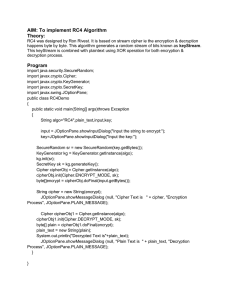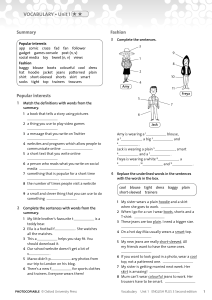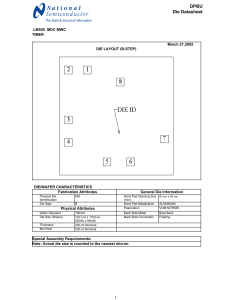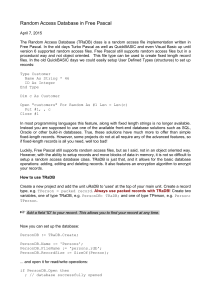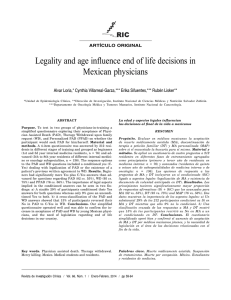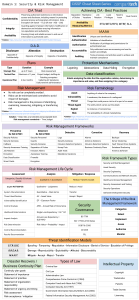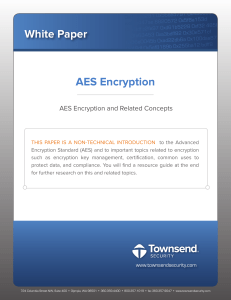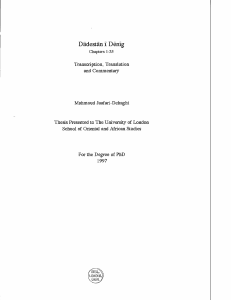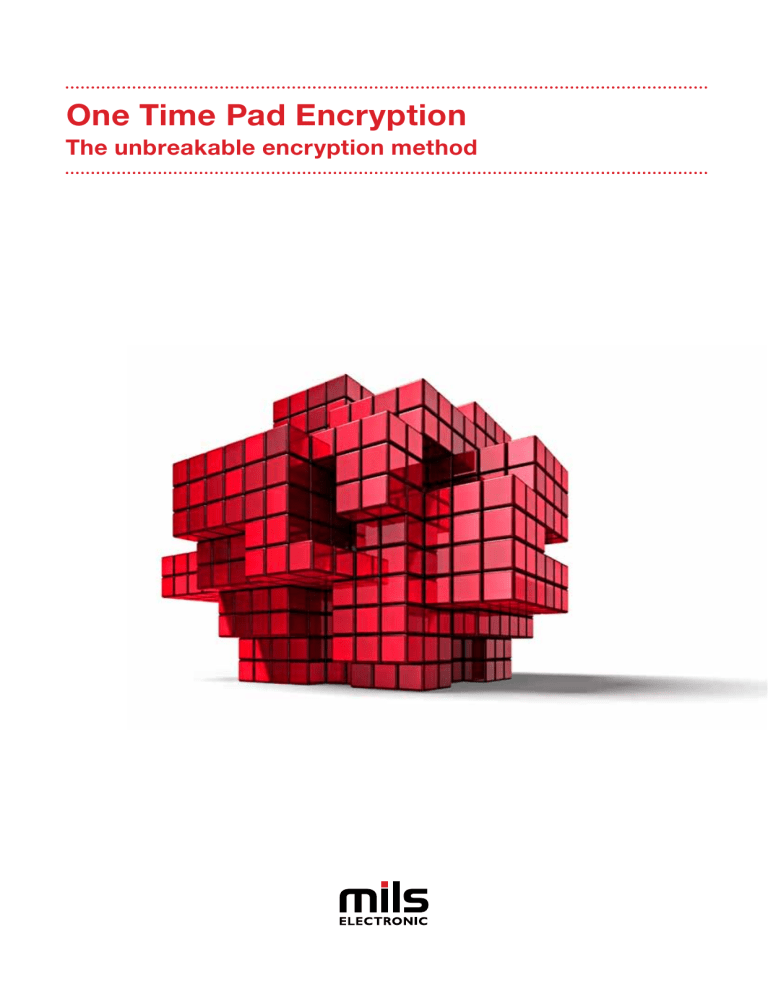
One Time Pad Encryption
The unbreakable encryption method
One Time Pad encryption is
the only proven unbreakable
encryption method
Dear Reader
One Time Pad encryption is a very simple, yet completely unbreakable cipher method. It has been used
for decades in mils electronic cipher systems for encrypting our customers’ sensitive data.
Over the years, we have perfected the implementation of One Time Pad encryption into our products.
Today, our high level of automation, high capacity storage media, continuous key protection and huge
One Time Pads offer our customers outstanding message security without sacrificing convenience.
This document will help you understand how One Time Pad can ensure complete privacy for your
sensitive information.
With best regards,
Otto Kugler
CEO
Characteristics of the
One Time Pad
encryption method
The One Time Pad encryption method is a binary additive stream cipher,
where a stream of truly random keys is generated and then combined
with the plain text for encryption or with the ciphertext for decryption by
an ‘exclusive OR’ (XOR) addition.
It is possible to prove that a stream cipher encryption scheme is
unbreakable if the following preconditions are met:
The key must be as long as the plain text.
The key must be truly random.
The key must only be used once.
The One Time Pad implementation in mils electronic’s products fulfils all
these requirements and therefore provides absolute protection for our
customers’ sensitive information.
How does it work?
True random key generation
For One Time Pad encryption, a truly random key stream must be employed. The word ‘random’ is used in its
most literal sense here.
In mils electronic products, all keys are exclusively generated by a ‘True Random Noise Source’. This Noise
Source is incorporated into the hardware security token of each mils electronic application. Integration into the
Security Token ensures tamper resistant protection and a very high key generation speed.
0
ing
10
110
101
its
om B
Rand
n
inatio
b
m
o
C tage
S
tor R
la
Oscil
In mils electronic products, all keys are
exclusively generated by a
‘True Random Noise Source’
The random noise source derives its random bits by sampling a set of parallel ring oscillators, a reliable
technology for obtaining truly random bits. This technique uses timing jitter and oscillator drift found in freerunning CMOS ring oscillators as a source of randomness. Timing jitter is a random phenomenon caused by
the thermal noise and local voltage variations present at each transistor of a ring oscillator.
Local variations in voltage and temperature will cause each ring to oscillate faster (or slower) over time resulting in a random drift relative to the other rings. As the frequency of each oscillator randomly drifts with
each cycle, the output stream becomes random relative to the lower frequency sampling rate.
The encryption process
One Time Pad keys are used in pairs. One copy of the key is kept by each user and the keys are distributed
securely prior to encryption.
The confidentiality and authenticity of the One Time Pad keys are assured by continuous protection during
their distribution and storage. This guarantees that outsiders will not be able to misuse the key (e.g. by
copying or altering the key during distribution).
01
011
10
0
1
0
00
0
1
1
xt
Te
Plain
sive
Exclu
OR
1
01
1
0
1
1 1 0er Text
1
0
1
Ciph
lting
Resu
10
0
1
1
0
tream
ey S
ime K
One T
01
011
0
01
01
111
11
101
0
1
oise
dom N
n
a
R
en
True
y the ecurity Tok
b
d
e
t
S
ra
of the
Gene
1
e
Sourc
To encrypt plain text data, the sender uses a key string equal in length to the plain text. The key is
used by mixing (XOR-ing) bit by bit, always a bit of the key with a bit of the plain text to create a bit
of cipher text.
This cipher text is then sent to the recipient.
At the recipient’s end, the encoded message is mixed (XOR-ed) with the duplicate copy of the One
Time Key and the plain text is restored.
Both sender’s and recipient’s keys are automatically destroyed after use, to ensure re-application of
the same key is not possible.
Why is One Time Pad
encryption unbreakable?
The popular scientific explanation
With One Time Pad encryption, the key used for encoding the message is completely random and is as long
as the message itself. That is why the only possible attack to such a cipher is a brute force attack.
r Text
Ciphe
RW
Z
L
X
KMQ
Key 1
Key 2
Key 3
Key 4
I TA
Q
P
V
Z C
R J V
Z
X
HSU
HWM
Y
D
E T
X
H
RXW
Z
LW
J
XOR
XOR
XOR
XOR
COM
C P
E
NOW
T V Z
A
QW
WM
Z
U
XS
Y
S TA
RJ
OFF
Plain
Plain
Plain
Plain
gful)
Text
anin
1 (me
Text
anin
2 (me
Text
anin
3 (me
gless)
gless)
ful)
aning
(me
Text 4
The ‘Brute Force’ attack
Brute force attacks use exhaustive trial and error methods in order
to find the key that has been used for encrypting the plain text. This
means that every possible combination of key bits must be used
to decrypt the cipher text. The correct key would be the one that
produces a meaningful plain text.
Unlimited computing power is useless
Let’s assume an eavesdropper has intercepted a One Time Pad encrypted message
and that he has unlimited computing power and time. A brute force attack would be
very expensive for a plain text of reasonable size. For example, typical e-mail messages
are at least 200 bytes long, requiring the testing of 1.600 bits. Even if the eavesdropper
is both willing and able to do this, the following paragraph will describe why unlimited
computational power will not compromise the system.
Attackers must try every possible key
Since all One Time Keys are equally likely and come from a completely unpredictable
noise source that is provably random, the attacker has to test all possible key strings.
Impossible to guess the right plain text
If he used every possible key string to decrypt the cipher text, all potential plain text strings with the same
length as the original plain text data would appear. As illustrated on the left-hand side, most of these potential
plain text strings would not make sense; however, every meaningful string the same length as the original plain
text data would also appear as a potential plain text string.
Without knowing the applied OTP, the eavesdropper has no way of finding out which meaningful string is the
original plain text. Thus, trying all possible keys doesn’t help the attacker at all, since all possible plain texts are
equally likely decryptions of the cipher text.
Why is One Time Pad
encryption unbreakable?
The mathematical proof
According to Alfred Menezes et al. in their book, Handbook of Applied Cryptography, a system can be called
perfectly secret, or unconditionally secure, when observing cipher text gives an eavesdropper no additional
information about the original plain text string. If we let L be the number of bits in the plain text string, then i
ranges from 1 to L in the following definitions:
pi
= the ith bit in the plain text string
ci
= the ith bit in the cipher text string
ki
= the ith bit in the key string
P( pi )
= the probability that pi was sent
P( pi | ci )
= the probability that pi was sent given that ci was observed
A system can be called perfectly secret when P( pi ) = P( pi | ci ). This section will prove that an One Time Pad
system is perfectly secret.
In traditional stream cipher systems, the most common method of mixing plain text data bits with key bits is by
performing the XOR operation on the corresponding bits. XOR is short for exclusive OR. The following is a table
that defines XOR (you can think of column a as a bit of plain text and column b as its corresponding key bit):
a
b
a XOR b
0
0
0
0
1
1
1
0
1
1
1
0
The sender makes cipher text by XOR-ing plain text and key one bit at a time:
ci = pi XOR ki (1)
where ci, pi, and ki are as defined above.
Because the One Time Pad key is completely random and unpredictable, two conclusions can be drawn:
First, the probability of observing any particular One Time Pad key bit is equal to the probability of
observing any other One Time Key bit.
Second, knowing all the previous values of key in a sequence tells us nothing about the next key bit.
By stating another definition,
P(ki) = the probability that ki was used to create ci
the first conclusion drawn above can be written as
P( ki=1 ) = P( ki=0 ) = 1/2 for all i. (2)
In other words, a bit of One Time Key is just as likely to be a 1 as a 0 at any time. The second conclusion drawn
above allows us to consider triples of key, cipher text, and plain text for a particular value of i without regard
for other triples.
Equation (1) leads to an important observation: knowing any two of {pi , ci , ki } determines the third. Likewise,
given one of {pi , ci , ki }, a second one can be written in terms of the third. For example,
P( ci=1 | ki=0 ) = P( pi=1 );
in other words, if we know for a fact that the key bit is 0, then plain text and cipher text must be equal.
In order to show that P( pi | ci ) = P( pi ), we first need to show P( ci ) = P( ci | pi ). Using equation (1), we will do
this explicitly by first deriving the distribution of P( ci ). Next, we will derive the distribution of P( ci | pi ) given
that the plain text bit is a 0 and then given that it is a 1.
Distribution of P( ci )
P( ci=1 ) = P( ci=1 | ki=1 ) P( ki=1 ) + P( ci=1 | ki=0 ) P( ki=0 )
by the definition of conditional probability
= P( pi=0 ) P( ki=1 ) + P( pi=1 ) P( ki=0 )
by equation (1)
= P( pi=0 ) ( 1/2 ) + P( pi=1 ) ( 1/2 )
by equation (2)
= ( 1/2 ) [ P( pi=0 ) + P( pi=1 ) ] regrouping
= 1/2
since pi can only be 1 or 0
P( ci=0 ) = P( ci=0 | ki=1 ) P( ki=1 ) + P( ci=0 | ki=0 ) P( ki=0 )
by the definition of conditional probability
= P( pi=1 ) P( ki=1 ) + P( pi=0 ) P( ki=0 )
by equation (1)
= P( pi=1 ) ( 1/2 ) + P( pi=0 ) ( 1/2 )
by equation (2)
= ( 1/2 ) [ P( pi=1 ) + P( pi=0 ) ] regrouping
= 1/2
since pi can only be 1 or 0
Distribution of P( ci | pi )
If pi=0:
P( ci=0 | pi=0 ) = P( ki=0 )
by equation (1)
= 1/2
by equation (2)
P( ci=1 | pi=0 ) = P( ki=1 )
by equation (1)
= 1/2
by equation (2)
If pi=1:
P( ci=0 | pi=1 ) = P( ki=1 )
by equation (1)
= 1/2 by equation (2)
P( ci=1 | pi=1 ) = P( ki=0 )
by equation (1)
= 1/2
by equation (2)
It is clear from the distributions derived above that P( ci | pi ) = P( ci ). Recall that a system can be called
perfectly secret when P( pi ) = P( pi | ci ). Using the definition of conditional probability, the joint probability,
P( pi and ci ), the probability that pi and ci are observed, can be written in the following two (equivalent) forms:
P( pi and ci ) = P( ci | pi ) P( pi )
and
P( pi and ci ) = P( pi | ci ) P( ci ).
Combining the two equations gives
P( pi | ci ) P( ci ) = P( ci | pi ) P( pi ).
Since P( ci | pi ) = P( ci ) as shown above, these two terms cancel, leaving P( pi | ci ) = P( pi ), which is the
condition for perfect secrecy.
The history of
One Time Pad encryption
The One Time Pad encryption method is nothing new. In 1917, Gilbert Vernam invented a cipher solution for a
teletype machine. U.S. Army Captain Joseph Mauborgne realized that the character on the key tape could be
completely random. Together, they introduced the first One Time Pad encryption system.
Gilbert Vernam
Joseph Mauborgne
The famous patent for the ‘Secret
Signaling System’ from 1919. Each
character in a message was combined
with a character on a paper tape key.
Since then, One Time Pad systems have
been widely used by governments around
the world. Outstanding examples of a One
Time Pad system include the ‘hot line’
between the White House and the Kremlin
and the famous Sigsaly speech encryption
system.
The ‘Sigsaly’ system
Another development was the paper pad system.
Diplomats had long used codes and ciphers
for confidentiality. For encryption, words
and phrases were converted to groups of
numbers and then encrypted by using a One
Time Pad.
A ‘One Time Pad’
To date, customers in more than 60 countries have benefited from the unconditional
security that the One Time Pad encryption of our products provide.
Further readings
Schneier, Bruce:
Applied Cryptography: Protocols, Algorithms, and Source Code in C.
1996, John Wiley and Sons, Inc.
New York, Chichester, Brisbane, Toronto, Singapore
Menezes, Alfred J., Paul C. van Oorschot, and Scott A. Vanstone:
Handbook of Applied Cryptography
1997, CRC Press
Boca Raton, New York, London, Tokyo
mils electronic gesmbh & cokg | leopold-wedl-strasse 16 | 6068 mils | austria
t +43 5223 57710-0 | f +43 5223 57710-110 | [email protected] | www.mils.com
TEC-OTP-03e-01
